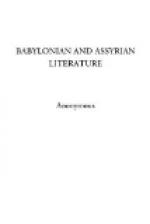May Nabu, the supreme Watcher, strike him with misfortune and ruin, and blast his happiness that he not obtain it, in the wrath of his face.
May all the great gods whose names are recorded on this tablet, curse him with irrevocable malediction, and scatter his race even to the last days.
[Footnote 1: This seems to be a usual formula.]
(This monument is equally engraved on a black basalt stone; it offers the same arrangement as the stone of Michaux. The analogous documents show that numerous inaccuracies have been committed.
In the upper part there occur the same altars, tiaras, birds, as well as the above-mentioned goat, dog, scorpion, and snake. The surface of the basso-relievo is also covered with Cuneiform writing.
The inscriptions are arranged in four columns, and take both sides of the monument. The first column originally finished at the 30th line; it seems to have been completed by four lines, which contain one of the essential articles of the contract, but which evidently are not in their right place, and had been actually forgotten in the original engraving.
On the margins and the bassso-relievo many additions and repetitions are to be read, which also prove the engraver’s carelessness or precipitation.)
20 hins[1] of corn are sufficient to seed an arura,[2] a field in the land of Zunire,[3] on the bank of the river Zirzirri, belonging to the house of Ada.
Marduk-idin-akhe, King of Babylon, has thus sentenced according to the laws of the country of Assur. Bin-zir-basa, his Minister, has favored Marduk-ilusu, son of Ina-e-saggatu-irbu,[4] who has written this to the King of Babylon: I say, He has loaded me with favors, and I proclaim that this rating has been made according to the epha[5] of the King of Babylon.
20 hin of corn are sufficient to seed an arura. Bin-zir-basa, the Lieutenant (of the King) has invested him with it, and (the measurer of lands) has thus measured it for the time to come.
In the length[6] above toward the North, turned to the river Zirzirri, adjoining the house of Ada, and the field of the house of the Satraps. In the length below, toward the South of the river Atab-du-Istar, adjoining the house of Ada. In breadth above toward the East, adjoining the limits of Bit-ulbar. In breadth below toward the West, adjoining the house of Ada.
According to the law of Marduk-idin-akhe, King of Babylon, servant of the gods of the City of the eternal fire,[7] it was so measured by Bel-zir-kini, son of Zikar-Istar, the measurer of the field.
In the town of Dindu, in the month of Tebet, on the 28th day (December) in the 10th year of Marduk-idin-akhe, King of Babylon.
In the presence of Bet-ulbar-sakimu, son of Bazi, Chief of the ru-bar of the countries;
in the presence of Babilai, son of Sin-mustesir,[8] Chief of the head Rulers of the country;




